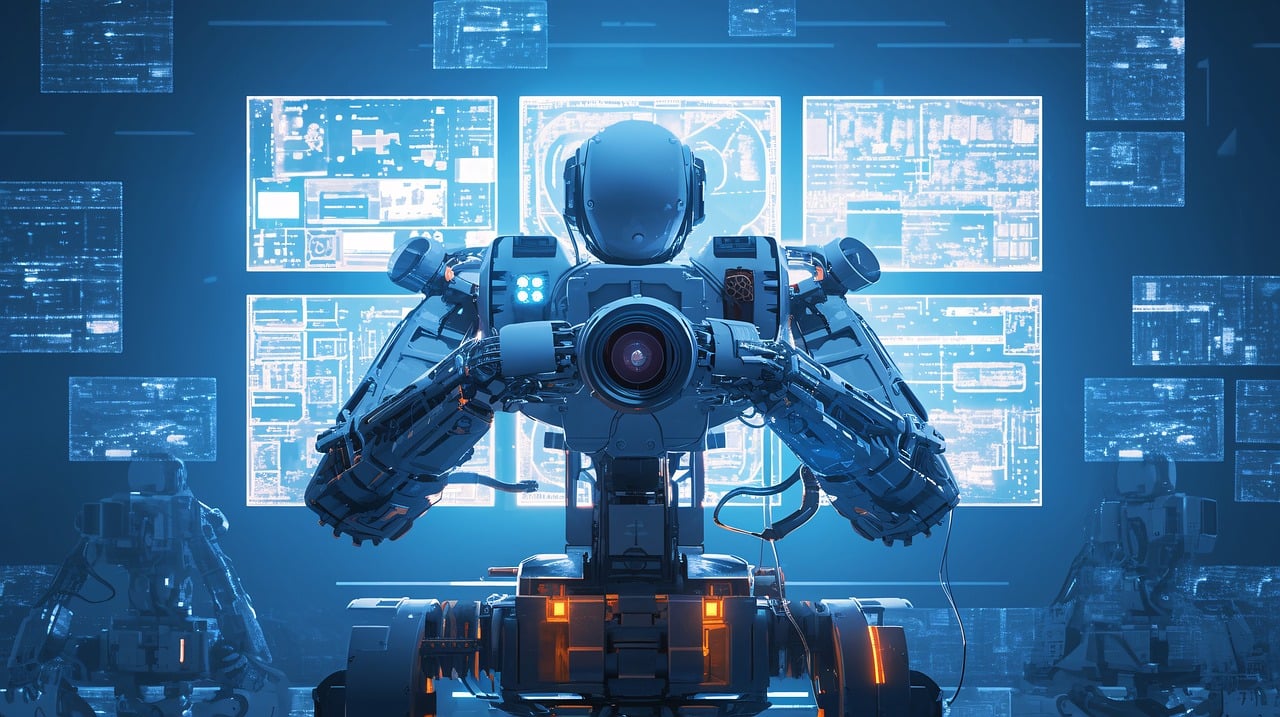
Latest NEWS
Unveiling the Future of Vision Technology: Exploring the Top 5 Key Trends at Vision Stuttgart 2024

Machine Vision and Imaging Systems at Vision Stuttgart 2024
Unveiling the Future of Vision Technology: Exploring the Top 5 Key Trends at Vision Stuttgart 2024
Machine Vision and Imaging Systems at Vision Stuttgart 2024

First and foremost, artificial intelligence (AI) is expected to play a significant role in the development of vision technology. AI-powered algorithms have the potential to revolutionize image processing and analysis, enabling machines to interpret visual data with unprecedented accuracy and speed. This trend will pave the way for more intelligent and autonomous systems, capable of performing complex tasks in various industries, from manufacturing to healthcare.
Another trend that will dominate Vision Stuttgart 2024 is the integration of 3D imaging technologies. Traditional 2D imaging systems have their limitations when it comes to depth perception and object recognition. However, with the advent of 3D imaging, machines can capture and analyze spatial information, enabling them to better understand their surroundings. This breakthrough will have a profound impact on applications such as robotics, quality control, and augmented reality.
Furthermore, the miniaturization of vision systems will be a key focus at Vision Stuttgart 2024. As technology continues to advance, the size of imaging sensors and cameras is shrinking, making them more compact and lightweight. This trend opens up new possibilities for vision technology in areas where space is limited, such as mobile devices, wearables, and drones. Smaller vision systems also mean reduced costs, making them more accessible to a wider range of industries and applications.
In addition to miniaturization, the development of high-resolution imaging systems will be a major highlight at Vision Stuttgart 2024. Higher resolution means more detailed and accurate image capture, allowing for better analysis and decision-making. This trend will have significant implications for industries that require precise measurements and inspections, such as automotive, electronics, and pharmaceuticals. High-resolution imaging systems will enable manufacturers to detect even the smallest defects and ensure the highest quality standards.
Last but not least, the integration of vision technology with other emerging technologies will be a key trend at Vision Stuttgart 2024. For instance, the combination of machine vision and Internet of Things (IoT) will enable real-time data analysis and decision-making, leading to more efficient and automated processes. Similarly, the integration of vision technology with robotics will enhance the capabilities of autonomous systems, enabling them to perform complex tasks with precision and accuracy.
In conclusion, Vision Stuttgart 2024 will showcase the top 5 key trends in machine vision and imaging systems. Artificial intelligence, 3D imaging, miniaturization, high-resolution imaging, and integration with other emerging technologies will shape the future of vision technology. These trends will revolutionize industries, improve efficiency, and enable machines to perceive and interpret visual data like never before. As we eagerly anticipate Vision Stuttgart 2024, it is clear that the future of vision technology is bright, promising a world where machines can see and understand the world around them with unparalleled clarity and intelligence.
The Role of Artificial Intelligence in Vision Technology
Unveiling the Future of Vision Technology: Exploring the Top 5 Key Trends at Vision Stuttgart 2024
The Role of Artificial Intelligence in Vision Technology
Artificial Intelligence (AI) has become an integral part of various industries, and the field of vision technology is no exception. As we delve into the top trends at Vision Stuttgart 2024, it is evident that AI is playing a crucial role in shaping the future of this industry.
One of the key areas where AI is making significant strides is in object recognition. Traditional computer vision techniques often struggled with accurately identifying objects in complex scenes. However, with the advent of AI, deep learning algorithms have revolutionized object recognition capabilities. These algorithms can now detect and classify objects with remarkable accuracy, even in challenging environments.
Another area where AI is making a profound impact is in image enhancement. Vision technology heavily relies on capturing high-quality images for analysis and decision-making. AI algorithms can now enhance images by reducing noise, improving contrast, and even filling in missing details. This advancement in image enhancement techniques has opened up new possibilities for vision technology applications, such as medical imaging and autonomous vehicles.
AI is also driving advancements in real-time video analytics. Traditional video analytics techniques often struggled with processing large amounts of data in real-time. However, AI-powered algorithms can now analyze video streams in real-time, enabling applications like surveillance, crowd monitoring, and traffic management. These AI algorithms can detect and track objects, recognize patterns, and even predict future events, making video analytics more efficient and effective.
Furthermore, AI is enabling the development of intelligent vision systems. These systems can learn from data and adapt their behavior based on experience. By combining AI with vision technology, machines can now perceive and understand the world around them, making autonomous decision-making possible. This has significant implications for industries like robotics, where intelligent vision systems can navigate complex environments and interact with objects and humans.
Lastly, AI is driving the integration of vision technology with other emerging technologies. For example, AI-powered vision systems can be combined with augmented reality (AR) to create immersive experiences. By overlaying digital information onto the real world, AR enhances human perception and interaction. This integration of AI and AR has applications in fields like manufacturing, where workers can receive real-time instructions and guidance through AR glasses.
In conclusion, the role of AI in vision technology is undeniable. From object recognition to image enhancement, real-time video analytics to intelligent vision systems, and integration with other emerging technologies, AI is shaping the future of this industry. As we explore the top trends at Vision Stuttgart 2024, it is clear that AI is driving innovation and pushing the boundaries of what is possible in vision technology. With continued advancements in AI, we can expect even more exciting developments in the years to come.
Advancements in 3D Vision and Depth Sensing Technologies
Unveiling the Future of Vision Technology: Exploring the Top 5 Key Trends at Vision Stuttgart 2024
Advancements in 3D Vision and Depth Sensing Technologies
Vision Stuttgart 2024, the premier trade fair for vision technology, promises to showcase the latest innovations and trends that will shape the future of the industry. Among the many exciting developments, advancements in 3D vision and depth sensing technologies are expected to take center stage. These technologies have the potential to revolutionize various sectors, from manufacturing and robotics to healthcare and autonomous vehicles.
One of the key trends in 3D vision technology is the increasing adoption of time-of-flight (ToF) sensors. ToF sensors use infrared light to measure the distance between the sensor and objects in its field of view. This technology enables accurate depth sensing and allows for the creation of detailed 3D models. With improved resolution and faster response times, ToF sensors are becoming an integral part of applications such as object recognition, gesture control, and augmented reality.
Another significant trend is the integration of artificial intelligence (AI) algorithms into 3D vision systems. AI-powered algorithms can analyze vast amounts of data captured by 3D sensors, enabling real-time decision-making and automation. This integration opens up new possibilities for applications such as quality control, robotic guidance, and object tracking. By combining the power of AI with 3D vision, industries can achieve higher levels of efficiency, accuracy, and productivity.
Furthermore, the development of compact and lightweight 3D cameras is driving the adoption of 3D vision technology in portable devices. These cameras, often based on stereo vision or structured light techniques, can capture depth information with high precision. As a result, smartphones, tablets, and wearable devices can now offer advanced features such as facial recognition, augmented reality gaming, and 3D scanning. The miniaturization of 3D cameras is not only enhancing user experiences but also opening up new markets and applications.
In addition to advancements in 3D vision, depth sensing technologies are also evolving rapidly. One notable trend is the emergence of solid-state LiDAR sensors. Traditional LiDAR systems rely on mechanical components to scan the environment, making them bulky and expensive. Solid-state LiDAR, on the other hand, utilizes semiconductor technology to generate and detect laser beams, eliminating the need for moving parts. This breakthrough enables the development of smaller, more affordable LiDAR sensors that can be integrated into various devices, including autonomous vehicles, drones, and industrial robots.
Lastly, the fusion of 3D vision and depth sensing technologies with other sensing modalities is a trend that holds great promise. By combining data from multiple sensors, such as cameras, LiDAR, and radar, a more comprehensive understanding of the environment can be achieved. This sensor fusion approach enhances perception capabilities, enabling applications such as advanced driver assistance systems, smart surveillance, and collaborative robots. The integration of different sensing modalities is expected to play a crucial role in the development of intelligent systems that can operate in complex and dynamic environments.
In conclusion, the advancements in 3D vision and depth sensing technologies showcased at Vision Stuttgart 2024 are set to shape the future of the vision technology industry. From the adoption of ToF sensors and AI algorithms to the miniaturization of 3D cameras and the emergence of solid-state LiDAR, these trends are driving innovation across various sectors. Moreover, the fusion of 3D vision and depth sensing with other sensing modalities is unlocking new possibilities for intelligent systems. As we explore these key trends, it becomes evident that the future of vision technology is bright and full of exciting possibilities.
Exploring Embedded Vision Solutions at Vision Stuttgart 2024
Embedded vision solutions are revolutionizing the way we perceive and interact with the world around us. As technology continues to advance at an unprecedented pace, the possibilities for embedded vision are expanding, and the future looks promising. At Vision Stuttgart 2024, the leading trade fair for machine vision, five key trends emerged that shed light on the future of vision technology.
The first trend that caught the attention of industry experts is the integration of artificial intelligence (AI) into embedded vision systems. AI algorithms are becoming increasingly sophisticated, enabling machines to analyze and interpret visual data in real-time. This opens up a world of possibilities for applications such as autonomous vehicles, robotics, and smart surveillance systems. With AI-powered embedded vision, machines can make intelligent decisions based on visual inputs, leading to enhanced efficiency and accuracy.
Another trend that is gaining momentum is the miniaturization of embedded vision systems. As technology becomes smaller and more powerful, the size of vision sensors and processors is shrinking, making it possible to embed them in a wide range of devices. From smartphones and wearables to industrial machinery and medical equipment, embedded vision is becoming ubiquitous. This miniaturization trend is driven by the need for compact and lightweight solutions that can be seamlessly integrated into various applications.
The third trend that emerged at Vision Stuttgart 2024 is the increasing demand for real-time processing capabilities in embedded vision systems. As the world becomes more connected and data-driven, the need for instant analysis and response is paramount. Embedded vision solutions that can process visual data in real-time enable applications such as facial recognition, object detection, and augmented reality. This trend is driven by the growing demand for faster and more efficient processing power to handle the ever-increasing volume of visual data.
In addition to real-time processing, the fourth trend that is shaping the future of embedded vision is the integration of 3D imaging technologies. Traditional 2D vision systems have their limitations when it comes to depth perception and object recognition. By incorporating 3D imaging technologies such as time-of-flight (ToF) sensors and structured light cameras, embedded vision systems can accurately capture and analyze the depth and shape of objects. This opens up new possibilities for applications such as gesture recognition, 3D mapping, and virtual reality.
The final trend that stood out at Vision Stuttgart 2024 is the focus on energy efficiency in embedded vision solutions. As the demand for embedded vision increases, so does the need for energy-efficient systems that can operate for extended periods without draining the power source. This trend is driven by the growing adoption of embedded vision in battery-powered devices such as drones, smartphones, and IoT devices. By optimizing power consumption and implementing energy-saving techniques, embedded vision systems can deliver high-performance capabilities while maximizing battery life.
In conclusion, the future of vision technology is bright, and the trends observed at Vision Stuttgart 2024 provide a glimpse into what lies ahead. From the integration of AI and miniaturization to real-time processing, 3D imaging, and energy efficiency, embedded vision solutions are poised to transform various industries. As technology continues to evolve, it is crucial for businesses and researchers to stay abreast of these trends and harness the power of embedded vision to unlock new possibilities and drive innovation. Vision Stuttgart 2024 has undoubtedly paved the way for a future where embedded vision becomes an integral part of our daily lives.
Vision-guided Robotics and Automation: A Glimpse into the Future
Unveiling the Future of Vision Technology: Exploring the Top 5 Key Trends at Vision Stuttgart 2024
Vision-guided Robotics and Automation: A Glimpse into the Future
The field of vision-guided robotics and automation has been rapidly evolving, and the Vision Stuttgart trade fair has always been at the forefront of showcasing the latest advancements in this field. As we look ahead to Vision Stuttgart 2024, it is clear that the future of vision technology holds immense potential for revolutionizing industries across the globe.
One of the key trends that will be explored at Vision Stuttgart 2024 is the integration of artificial intelligence (AI) into vision-guided robotics. AI has already made significant strides in various industries, and its application in vision technology is set to transform the way robots perceive and interact with their environment. By leveraging AI algorithms, robots will be able to analyze visual data in real-time, enabling them to make intelligent decisions and adapt to dynamic situations.
Another trend that will be showcased at Vision Stuttgart 2024 is the increasing use of 3D vision technology in robotics and automation. Traditional 2D vision systems have limitations when it comes to depth perception, but with the advancements in 3D vision technology, robots will be able to accurately perceive the shape and depth of objects in their surroundings. This will open up new possibilities for tasks that require precise manipulation and interaction with the environment.
Furthermore, Vision Stuttgart 2024 will shed light on the growing importance of collaborative robots, also known as cobots, in the field of vision-guided robotics. Cobots are designed to work alongside humans, assisting them in various tasks. With the integration of vision technology, cobots will be able to perceive their human counterparts and their surroundings, ensuring safe and efficient collaboration. This will revolutionize industries such as manufacturing, where humans and robots can work together seamlessly.
In addition to AI, 3D vision technology, and cobots, Vision Stuttgart 2024 will also explore the advancements in object recognition and tracking. With the ability to accurately identify and track objects, robots will be able to perform complex tasks with precision and efficiency. This will have a significant impact on industries such as logistics and warehousing, where robots can autonomously navigate and manipulate objects in dynamic environments.
Lastly, Vision Stuttgart 2024 will showcase the advancements in vision-guided robotics for quality control and inspection. With the integration of vision technology, robots will be able to detect defects and anomalies in products with high accuracy and speed. This will not only improve the overall quality of products but also reduce the need for manual inspection, saving time and resources for businesses.
In conclusion, Vision Stuttgart 2024 will provide a glimpse into the future of vision-guided robotics and automation. The integration of AI, 3D vision technology, cobots, object recognition and tracking, and quality control and inspection will revolutionize industries across the globe. As we explore these key trends, it is evident that vision technology will play a crucial role in shaping the future of robotics and automation, making tasks more efficient, safe, and precise. Vision Stuttgart 2024 is set to be an exciting event that will pave the way for a new era of vision-guided robotics.


